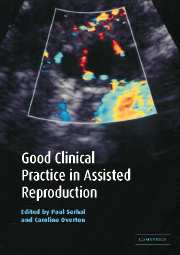13 results
13 - Guidelines on the Diagnosis and Management of Miscarriage
-
-
- Book:
- Early Pregnancy
- Published online:
- 16 February 2017
- Print publication:
- 02 February 2017, pp 129-145
-
- Chapter
- Export citation
1 - Organisation and delivery of emergency care in early pregnancy and acute gynaecology
-
-
- Book:
- Acute Gynaecology and Early Pregnancy
- Published online:
- 05 July 2014
- Print publication:
- 01 March 2011, pp 1-10
-
- Chapter
- Export citation
CHAPTER 4 - Access to early pregnancy care
-
-
- Book:
- Models of Care in Maternity Services
- Published online:
- 05 July 2014
- Print publication:
- 01 November 2010, pp 34-47
-
- Chapter
- Export citation
Preface
-
- Book:
- Good Clinical Practice in Assisted Reproduction
- Published online:
- 22 October 2009
- Print publication:
- 01 July 2004, pp xv-xvi
-
- Chapter
- Export citation
Plate section
-
- Book:
- Good Clinical Practice in Assisted Reproduction
- Published online:
- 22 October 2009
- Print publication:
- 01 July 2004, pp -
-
- Chapter
- Export citation
13 - Controversial issues in assisted reproduction
-
-
- Book:
- Good Clinical Practice in Assisted Reproduction
- Published online:
- 22 October 2009
- Print publication:
- 01 July 2004, pp 226-255
-
- Chapter
- Export citation
Contents
-
- Book:
- Good Clinical Practice in Assisted Reproduction
- Published online:
- 22 October 2009
- Print publication:
- 01 July 2004, pp v-vi
-
- Chapter
- Export citation
List of contributors
-
- Book:
- Good Clinical Practice in Assisted Reproduction
- Published online:
- 22 October 2009
- Print publication:
- 01 July 2004, pp vii-x
-
- Chapter
- Export citation
Index
-
- Book:
- Good Clinical Practice in Assisted Reproduction
- Published online:
- 22 October 2009
- Print publication:
- 01 July 2004, pp 342-348
-
- Chapter
- Export citation
17 - Setting up an IVF unit
-
-
- Book:
- Good Clinical Practice in Assisted Reproduction
- Published online:
- 22 October 2009
- Print publication:
- 01 July 2004, pp 289-309
-
- Chapter
- Export citation

Good Clinical Practice in Assisted Reproduction
-
- Published online:
- 22 October 2009
- Print publication:
- 01 July 2004
Frontmatter
-
- Book:
- Good Clinical Practice in Assisted Reproduction
- Published online:
- 22 October 2009
- Print publication:
- 01 July 2004, pp i-iv
-
- Chapter
- Export citation
Foreword by Bob Edwards
-
- Book:
- Good Clinical Practice in Assisted Reproduction
- Published online:
- 22 October 2009
- Print publication:
- 01 July 2004, pp xi-xiv
-
- Chapter
- Export citation



